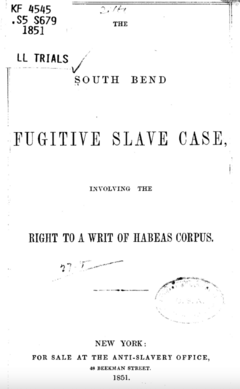Wright Modlin facts for kids
Quick facts for kids
Wright Modlin
|
|
|---|---|
| Born | March 26, 1797 Back Creek, Randolph County, North Carolina
|
| Died | December 20, 1866 (aged 69) |
| Other names | Wright Maudlin |
| Occupation | Farmer and teamster |
| Known for | As Underground Railroad conductor, he was a central figure in the Kentucky raid on Cass County of 1847 and The South Bend Fugitive Slave Case of 1849 |
| Spouse(s) |
Mary Wickersham
(m. 1817, d. 1838)Martha Rowlett
(m. 1838)Martha Rould
(m. 1847) |
| Parent(s) | Benjamin and Lea Maudlin |
Wright Modlin (1797–1866) was a brave farmer and teamster who played a big part in the Underground Railroad. This was a secret network that helped enslaved people find freedom. Modlin helped people escape slavery by transporting them between safe houses, called "stations." He even traveled south into states like Kentucky to guide people directly to Michigan, a free state.
Modlin often worked with his partner, William Holden Jones. Their success in helping so many people escape made slaveholders very angry. This anger led to an event known as the Kentucky raid on Cass County in 1847. Two years later, Modlin also helped his neighbors, the David and Lucy Powell family, escape after they were captured by their former slaveholder. This important case was called The South Bend Fugitive Slave Case.
Contents
Wright Modlin's Early Life
Wright Modlin was born on March 26, 1797, in Back Creek, Randolph County, North Carolina. He was the oldest son of Leah Copeland and Benjamin Maudlin. His parents had once owned enslaved people, but they decided to free them. Then, they moved north with their neighbors to a Quaker community in Whitewater, Indiana. Quakers were often against slavery.
On December 4, 1817, Wright Modlin married Mary Wickersham. They had four children together. After Mary passed away around 1838, he married Martha Jeanes Rowley. They had five children.
Helping People Escape Slavery
Modlin was a farmer and a teamster, which meant he drove wagons. He built a farm and a house in Williamsville, Michigan. This house became a secret station on the Underground Railroad.
Modlin was known as a "slave runner" because he helped people escape quickly. He and William Holden Jones traveled to places like the Ohio River and even into Kentucky. They helped freedom seekers travel north into free states, often directly to Michigan. This meant people could avoid many stops along the Underground Railroad. Modlin also acted as a scout and a spy, finding safe routes. The final goal for many was to reach Canada, where slavery was illegal.
A Daring Escape: The "Beautiful Girl"
Modlin once helped a young woman from Kentucky who was called "Beautiful Girl." She had light skin. They stopped at the Erastus Hussey house in Battle Creek, Michigan. To hide her, they disguised her as an old woman with a large sunbonnet that covered her face.
As Modlin drove her towards the Detroit River, four slave catchers started following them. To avoid being caught, Modlin and the "Beautiful Girl" pretended to be a couple looking for land to buy. The slave catchers believed them and left. Modlin and the young woman quickly continued their journey to the Detroit River. Just minutes after she got into a boat heading for Canada, the slave catchers arrived. They saw her in the river, but it was too late to capture her.
The South Bend Fugitive Slave Case

On October 9, 1847, David and Lucy Powell and their four sons escaped from slavery in Kentucky. They traveled north and settled near Cassopolis, Michigan, where they started a farm.
On September 27, 1849, their former slaveholder, John Norris, broke into the Powell's home with eight armed men. They captured Lucy and three of her sons. David and one son were not home. Lucy and her sons were tied up and put into a wagon, heading back to Kentucky.
Wright Modlin, who was their neighbor, quickly rode his horse about twenty miles to South Bend, Indiana. He hired a lawyer named Edwin B. Cocker. The lawyer asked a judge for a special order called a habeas corpus writ. This order would bring the Powells before the court.
Norris, the slave catchers, and the Powells stopped about a mile south of South Bend. A deputy sheriff served Norris with the writ, and the Powells were brought to South Bend. The judge ruled that Norris did not have the correct papers to recapture the Powells, as required by law. He ordered them to be freed!
However, Norris and his men showed their weapons in the courtroom. It turned out Norris had another writ from an Indiana law that helped slaveholders. So, the Powells were put in jail for the weekend to wait for another trial. Many of the family's neighbors, both black and white, came to South Bend to support them. Seeing so many people, Norris decided to drop the case. He then sued for damages instead. This whole event was called The South Bend Fugitive Slave Case of 1849. The Powells later moved to Canada to be truly free.
The Kentucky Raid on Cass County
Wright Modlin and William Holden Jones made many trips to the Ohio River, which was the border between states where slavery was allowed and states where it was not. They even went further south into Kentucky to help enslaved people travel north to freedom.
Slaveholders were very angry about how many enslaved people were escaping. Because of this, they planned what is known as the Kentucky raid on Cass County in 1847. They hoped to get their former enslaved people back.

